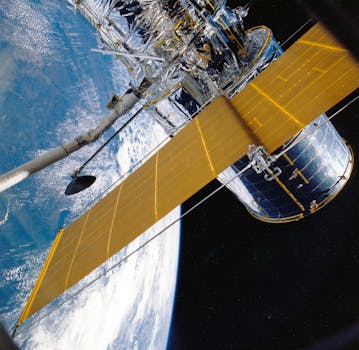
The Future of Satellites: Revolutionizing Global Connectivity
The future of satellites is a topic of great interest and importance, as these space-based devices play a crucial role in facilitating global connectivity, navigation, and communication. With the rapid advancement of space technology, the satellite industry is poised for significant growth and transformation in the coming years. In this article, we will delve into the latest trends and developments in the satellite industry, and explore the exciting possibilities that the future holds.
Advancements in Space Technology
One of the key drivers of the satellite industry’s growth is the rapid advancement of space technology. Recent years have seen significant improvements in launch systems, satellite design, and propulsion systems, making it possible to build and launch more efficient, cost-effective, and powerful satellites. For instance, the development of reusable launch vehicles, such as those developed by SpaceX and Blue Origin, has significantly reduced the cost of accessing space, making it more feasible for companies and governments to launch satellites into orbit.
Another area of advancement is in the field of satellite manufacturing, where new materials and technologies are being developed to create smaller, lighter, and more efficient satellites. This has led to the emergence of small satellite constellations, which offer a range of benefits, including increased coverage, improved communication capabilities, and enhanced navigation services. Companies such as OneWeb and Amazon’s Kuiper Systems are leading the charge in this area, with plans to launch thousands of small satellites into low Earth orbit in the coming years.
Increasing Demand for Global Connectivity
The demand for global connectivity is driving the growth of the satellite industry, as more and more people around the world require access to fast, reliable, and affordable communication services. According to a report by the International Telecommunication Union (ITU), the number of internet users worldwide is expected to reach 5.3 billion by 2023, up from 3.8 billion in 2017. This growing demand for connectivity is creating new opportunities for satellite operators, who are well-positioned to provide communication services to remote and underserved communities.
Satellites are also playing a critical role in the development of the Internet of Things (IoT), which is expected to connect billions of devices worldwide in the coming years. With their ability to provide global coverage and communicate with devices in remote and hard-to-reach areas, satellites are an essential component of IoT infrastructure. Companies such as Iridium and Globalstar are already providing satellite-based IoT services, and this market is expected to grow significantly in the coming years.
Future Developments and Trends
As the satellite industry continues to evolve, we can expect to see a range of new developments and trends emerge. One area of focus is the development of satellite-based navigation systems, such as the European Union’s Galileo system and the US’s GPS system. These systems provide critical infrastructure for a range of applications, including aviation, maritime, and land transportation, and are essential for modern navigation and communication.
Another area of development is in the field of satellite-based Earth observation, where satellites are used to monitor the Earth’s environment, climate, and natural resources. This has a range of applications, including weather forecasting, disaster response, and environmental monitoring. Companies such as Planet Labs and DigitalGlobe are leading the charge in this area, with constellations of small satellites that provide high-resolution imagery and data on the Earth’s surface.
Conclusion
In conclusion, the future of satellites is promising, with advancements in space technology and increasing demand for global connectivity driving growth and innovation in the industry. As we look to the future, it is clear that satellites will play a critical role in shaping the modern world, from providing communication services to remote communities to monitoring the Earth’s environment and climate. With the rapid advancement of space technology and the emergence of new trends and developments, the satellite industry is poised for significant growth and transformation in the coming years.

